ReWilding Through Wild Fermentation
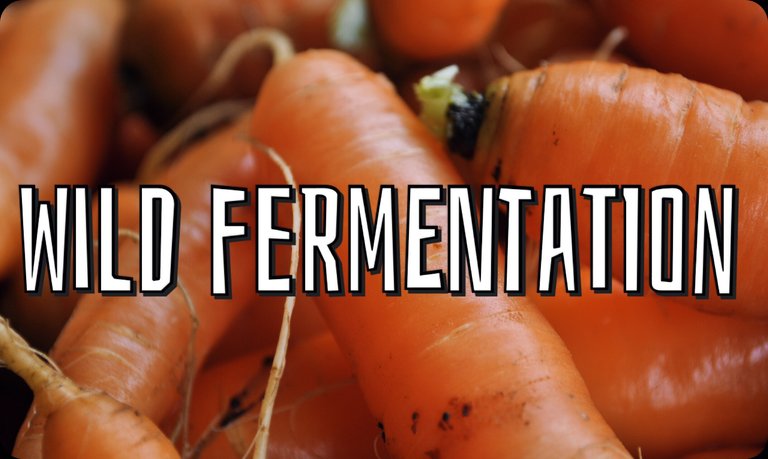
There’s a lot of public attention centered around probiotics, and rightfully so. Much of the mainstream consciousness is geared towards lab grown strains of isolated bacteria. While this is fine concept, there a much more ancient, empowered and accessible way to get probiotics. You can culture them in your own micro bioregion (your kitchen, for instance) to feed your unique microbiome.
The human microbiome is just coming to be understood as a crucial part of our health and immunity and perhaps even our survival. It is compromised of the numerous strains of (mostly) bacteria that live on and in our bodies. These organisms outnumber our own cells by 10 to 1!
This means that 90% of our bodies are made up of other bodies.
Whaaat? I know this sounds wild and it really is, but we have to remember that we (in our current homo sapien form) have co-evolved within the Earth’s biome for 200 000 years. The majority of our human history takes place well before we understood micro biology on an scientific level.
Gut Health: Putting It All Together

Knowing this and also understanding the well studied link between our immune system and gut health is crucial to living a healthy life.
Some sources claim that as much as 65% of our immune system function is dependent on the gut health, but we’ll save those details for another post ;). We've barricaded ourselves behind the sterile curtain of civilization and, in doing so, have limited our body's ability to relate to the natural world.
Our modern lifestyle has often created more of the problems that we set to solve, as in the case of some infectious outbreaks. The overzealous use of antibacterial technologies (most pernicious being antibiotic medicines) have created stronger and more resilient bacterial strains that are threatening our public health.
Armed with the knowledge of the importance of a heathy immune system and diverse gut bacteria, we can reclaim sovereignty of our microbiome.
With this amazing diversity of microbes living on and in our bodies, it behooves us to take care of these little critters. Plus when we employ them in our foods, they are literally predigesting the food for us so we can not only assimilate the foods better, but also ingest the protein from their bodies and diversity of metabolites.
Knowing all of this, what are some steps you can take to support your microbiome health?
What you can do?
- Avoid antibiotics whenever possible
- Drink naturally sourced water (especially important to be free of chlorine and fluoride)
- Eat a widely diverse diet rich in fiber (many of these strains of bacteria feed on fiber and are sometimes specific to a particular food)
- Avoid use of harsh soaps and excessive washing (our skin is full of colonies that don’t appreciate being constantly killed with chemical soaps)
- Go outside barefoot (in Episode 1 we focused on the feet)
- Allow your body to come in contact natural environments (forests duff, plants, soil etc.)
AND...
Eat foods rich in beneficial bacteria
We will explore the other points in future Episodes, but would like to offer a simple and versatile technique for supporting your microbiome through simple kitchen-witchin'.
Lacto Fermented Vegetables
We're most likely all familiar with sauerkraut or kimchi, but have you ever cultured other vegetables?
It's super easy and is a great way to make use of times of plenty (like when you're harvesting a bunch of radishes or carrots to make room for something else). The most common strain of bacteria that live on and digest vegetables are lactobacillus, leading to the name of this fermentation technique. There are others of course and the abundance of a particular strain depends on the temperature, place and stage of fermentation among other factors.
Get Cultured!
You don't need to be a microbiologist to grow your own microbes and feed your microbiome, just a few easy to obtain items will do:
- Vegetables
- Glass jar(s) and lids
- Salt
- Water
Step 1:
Clean jar or jars (depending on your scale and amount of vegetables to be cultured). The level of cleanliness is up to you. Hot water sterilization, hot soapy water, h2o2 or bleach [yikes] will all get the job done. Get it clean to however you feel comfortable.
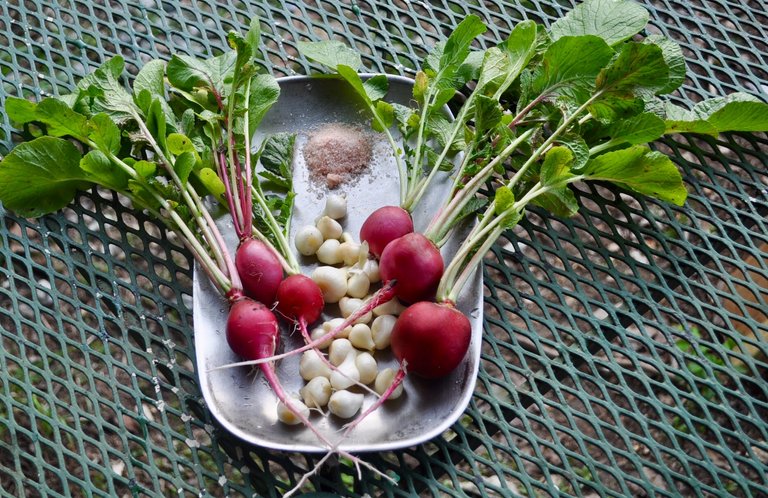
Step 3:
Wash and prep vegetables. Here I have harvested wild onions and radishes. I simply lightly scrub with a vegetable brush and run under cold water. The bacteria resides of the skin on many vegetables, and in the case of cabbage I don't bother with this step. I do wash the soil off roots though.
Step 3:
Prepare brine by mixing 1 Tbsp (30 ml) salt per quart of water (1L). A quart jar will require more or less a pint (500 ml) of brine depending on how you prepare the veggies. If you must use chlorinated tap water, boil it first to drive off the volatile gas that is added to kill bacteria.
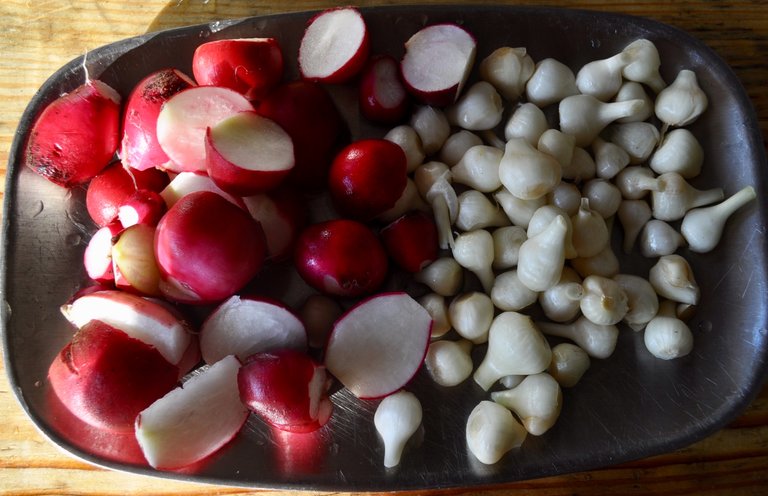
Step 4:
You can opt to leave veggies whole as I have done here or slice, dice or shred them. The smaller the particles, the faster it fill ferment and will result in a softer texture. I find this brining technique works better with larger chunks, but have fun with experimenting.
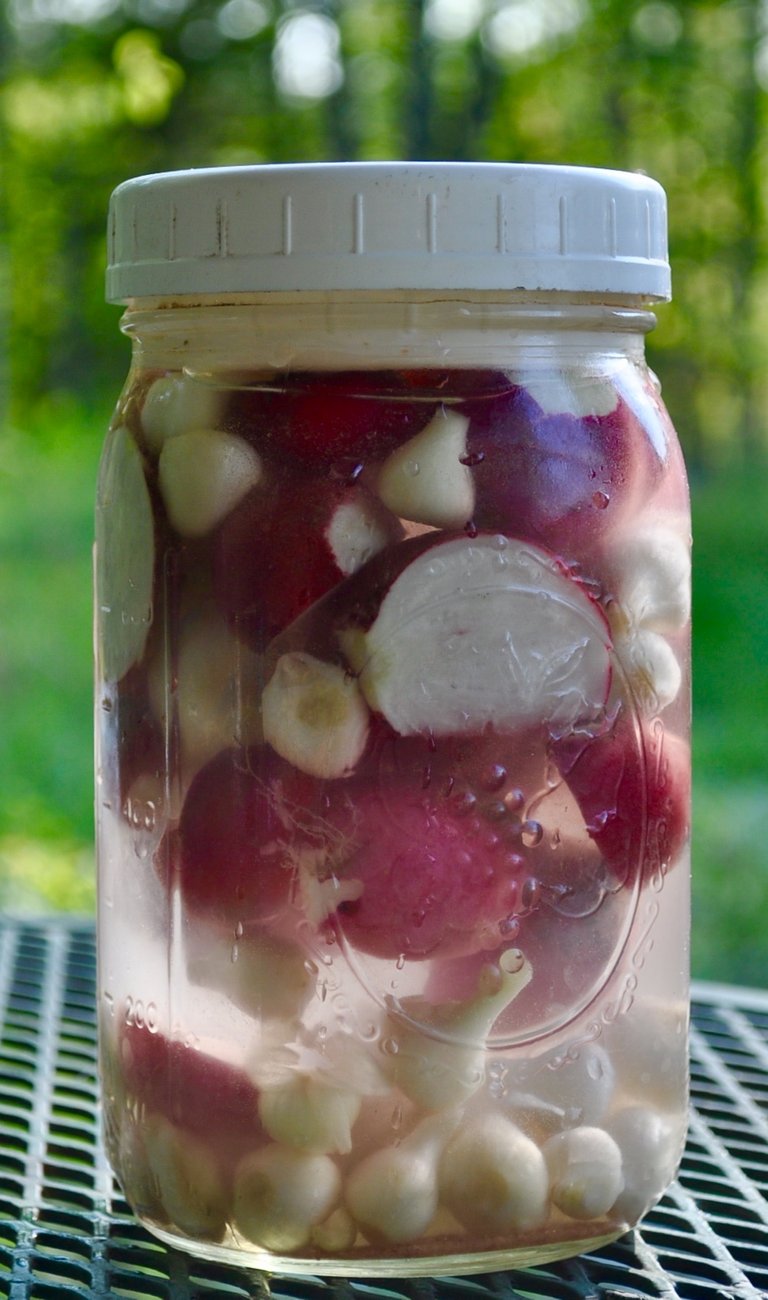
Step 5:
Fill your cleaned jar(s) with veggies and completely submerge under the brine. The bacteria you're looking to culture grow without oxygen (anaerobic) whereas mold prefer air (aerobic). I like to use plastic small mouth mason jar lids as a weight inside wide mouth quart jars. Metal is to be avoided as it may kill bacteria and maybe even leach unwanted metals into your ferment.
Step 6:
Set in a cool(ish) dark location to ferment. It can be eaten in as little as 2 days or allowed to ripen for quite some time. The choice is up to you. As the organisms digest the food, there is a succession of different strains, each with their own needs and flavor profiles.
Step 7:
Sit down and do a dance for your microbiome! Enjoy the results of employing the numerous microbes to support your heath and wellness.
Are there any favorites ferments or practices that you employ to support your microbiome?
Stay tuned for a DTube Carrot Lactoferment coming soon, as well as future posts and videos in our rewilding series.
Previously in @mountainjewel's ReWilding Series
Episode 1: ReWilding Your Movement | Remembering the Innate Abilities of Our Feet (Vlog)
Are Humans Being Factory Farmed? | The Truth of Human Domestication (ReWilding Intro)

banner by @radicalunicorn

written by a passenger of the #ecoTrain. check the tag often for more inspiring & educational posts!
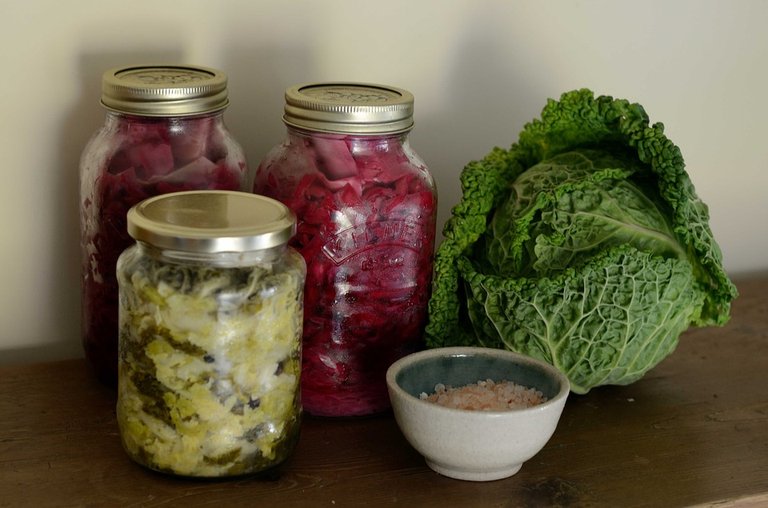
I am a fermenting newbie!
So far I’ve only used red cabbage with fennel and ginger. Maybe I will try radishes next.
I figured out how to keep mold away with my easy fermenter lids.
https://steemit.com/health/@mhrose/first-time-fermenter-3c25a60d5332#@mhrose/re-mhrose-201855t141436761z
yes enough salt is a very important aspect! glad to meet another fermenter- so easy right?
Just wanted ro know... for example, fermenting carrots, does it smell up the house like sauerkraut does? Only tried it once and it stunk up the whole apartment, lol.
It does smell a little, but cabbage has more sulphur which a leads to deeper dankness of odor. Carrots tend to be more mild.
So it's the sulfur that makesbit smell most I guess! I'm just impatient and our little apartment is full of boxes as we're packing up! I should wait just a couple more weeks before experimenting!
I am a fermenting newbie!
So far I’ve only used red cabbage with fennel and ginger. Maybe I will try radishes next.
I figured out how to keep mold away with my easy fermenter lids.
Here’s my post
Cabbage and fennel - YES. But with ginger? Sounds amazing. Thanks for the idea!
It’s a big hit in my family, and a beautiful color as well!
oh that color is where it's at- so vibrant!!
Yeah that sound really good!
Wow, I love wild fermentation ideas. I remember buying an excellent book by Sandor Katz on "The art of fermentation" on the health (as well as taste) benefits. Looking forward to future posts!
yes! best book!! we have this one, too. <3 thanks for stopping by.
Thanks for the reminder! I just threw out my grape juice kefir because it started smelling awkward. And started using lab created probiotics again, because I didn't want to bring bad bacteria in my gut with my kitchen witchin. :-) But this making veggies in brine has worked for me before, it's a short fermentation period and not much can go wrong and on top of that it is delicious! I love all my fermenting vegetables with pepper corns, garlic and ginger.
right on! yes it's pretty much foolproof!! glad to hear of your kitchin witchin! and mmm pepper, garlic, ginger- can't go wrong! :)
Very cool! I’m going to read this a little more thouroughly when I get home from work 😊
:) awesome to hear! let us know if you have ?s- it's super easy to make your own :)
What a wonderful post, @mountainjewel. There is something so gratifyingly delicious about fermenting your own veggies AND yes, the benefits are numerous ! Definitely some of the healthiest snacks out there ! Now, pardon me while I go nosh on some kimchi... :)
yes!! haha yesss my korean brother once called me a "kimchi killer" apropos for my love of it!!
that's your next steemit account handle !!
Have you guys heard of the Medical Medium, Anthony William? He has some really interesting natural health ideas, and talks about stuff that bio-medicine hasn't yet discovered.
I've just downloaded a couple of free samples of his Kindle books, via Amazon and am looking forward to reading them.
ah i think we have heard of him, if only briefly. doesn't he disagree with ferments? curious to know more!
I couldn't tell you about his views regarding the fermenting, tbh. I haven't really delved into his stuff (yet) but its on the back burner to do so.
The way he appears to get his information reminds me of Annie Besant ... I should re-read her stuff too. Mind-blowing!
yes, i have read some of her stuff. i am totally down with medical mediums and intuitives! such good stuff. i personally eat/live very intuitively as well and appreciate these voices <3
Wow, thanks for this valuable information! I have tried the usual sauerkraut and kimchi but nothing else. Looking forward to the carrot dtube! Should be epic! ox
:) aw thanks mom. we'll do it tomorrow as we just harvested a couple lbs of carrots from the high tunnel! we're going to make it with ini's sis :) <3 super easy!
I really love fennel and red cabbage sauerkraut. Unfortunately Jamie can't eat it, but I dont know how sad I am about that - more for me! ;) xxx
There are a LOT of great fermented krauts on the market here in Australia - seriously everywhere. Yet, like kombucha - they are so much cheaper to make yourself, let alone the freshness! My Mum is also a GUN at krauts - I have yet to get the sweet crunchy perfection of hers. I grew up on sauerkraut as Dad's side of hte family is German, but the stuff you used to get was pasteurized and not the same thing.
hahaha more for you! exactly how i feel about all of these ferments. i can eat an entire jar on my own... easily and happily!!
yes, you hit the nail on the head: the market is getting saturated, but the really high quality artisan products are usually very experience. so easy to make on one's own too! mmmm wow amazing to hear about your Mum! yes.... pasteurized is not the same thing-- i wonder when they're traditional "live" kraut became the product it is today? mass commercial production, likely.
top tips!!! i totally get it, and have been craving homemade fermented kimchi for a long time.. i occasionally make it, but i should have it more.. oh and vegan cheese is also a favourite fermented treat.. thanks for this valuable info!
Happy to remind and inform about how easy fermentation is! That craving is a deep longing for those tiny little beasties that help so much. I see you too have developed that sour tooth...
We almost always have some variation of seed cheese (sprouted and fermented pumpkin seeds) on the go. Wren actually asked for her bday last year that I make it everyday.
This is such a wonderful post - so well explained! Your photos have my stomach rumbling for some fermented goodness.
Thank you. Glad you enjoyed and always happy to make those rumbles. 'Tis the season for ferments! As the harvests roll in its all about keeping the microbes rolling, inside and out.
Can't wait to try this!!! Thank you for an excellent step by step recipe. I had been told to boil my chlorinated water for 10 minutes for my kombucha, so I guess I'll do the same. Unless someone tells me 10 minutes are too little!
I really want to try the radishes fermented like that now!
I think you're spot on for 10 mins, although at that rate you could use any water, as 10 will disinfect any source water. Plus if your source has fluoride, boiling won't get rid of it. Radishes are a real delight, just a few pick any meal up. Best luck in your ferment forays.
I still have a lot to learn on fluoride and making water safe in general! Thanks, I think I'll wait till we move in a couple weeks so I don't create more things to move!
I was just listening to Andrea Potter on the Abundant Edge podcast. Amazing stuff there too.
I'll have to check that podcast out. Thanks for the tip.
You're welcome, It's episode 0631 by the way
I keep telling myself that there is some combination of kimchi that would be tasty, but so far I haven’t found the right veges. Your recipe looks good, in the past all I could taste was garlic and salt. Thanks for the ideas. 🐓🐓
I hope you find that sweet spot for you. There's so many great avenues of fermentation to try! A pleasure to share. Looking forward to what you come up with.